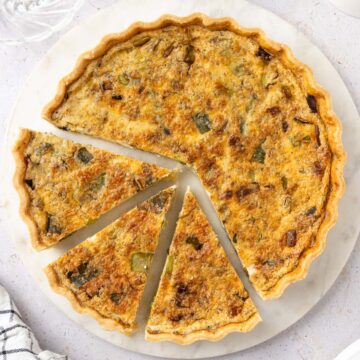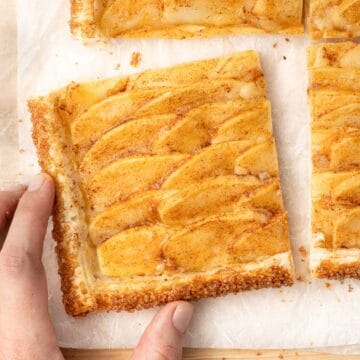This French Passion Fruit Tart is an incredibly fresh and delicious dessert that combines a Pâte Sucrée (sweet shortcrust pastry) and a Passion Fruit Crémeux (passion fruit cream filling). Optionally top it with meringue to create a real showstopper!
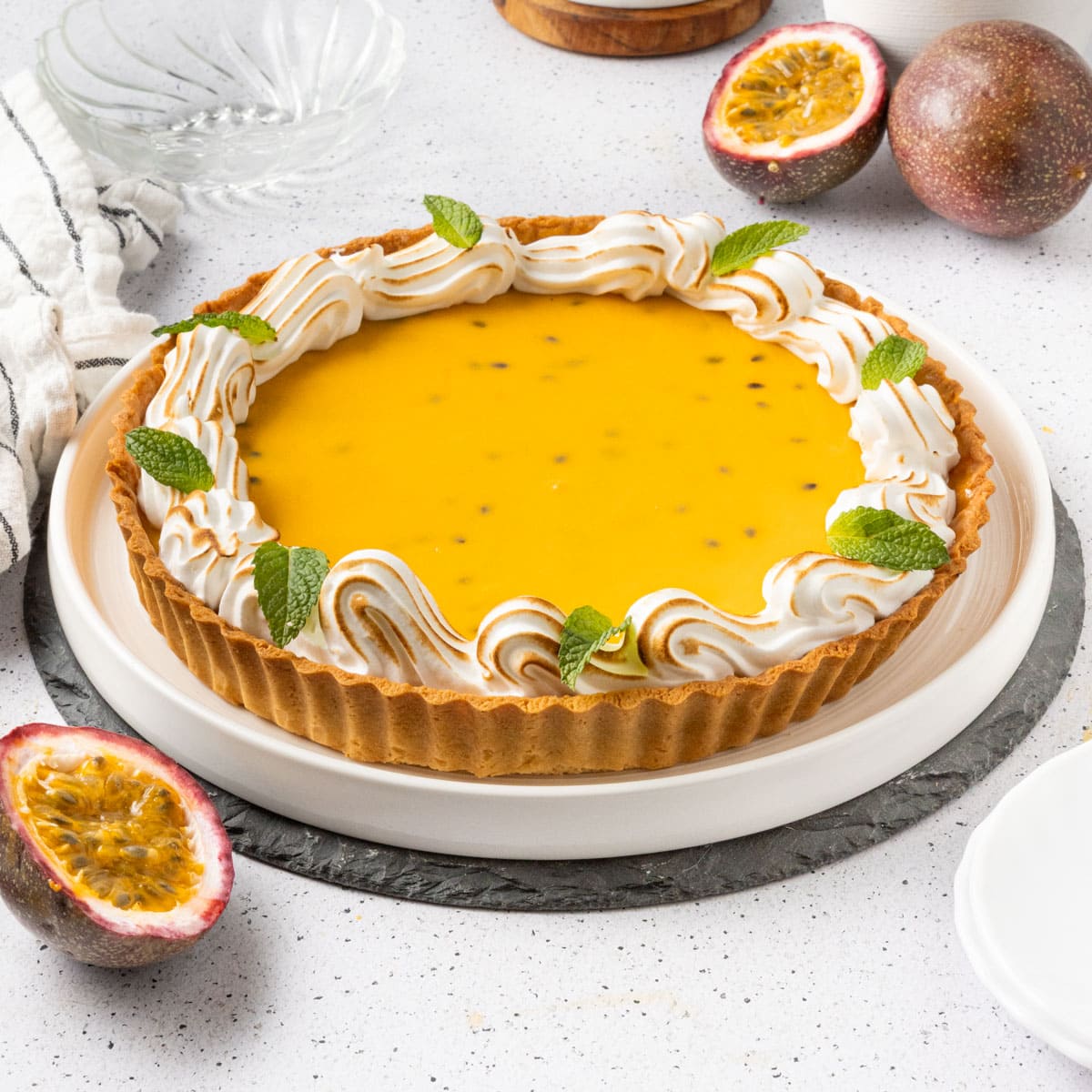
Jump to:
Why we love this recipe
Love a good lemon tart but want to try something a bit different? Make this passion fruit tart! With its crispy, buttery shortcrust pastry, creamy and tangy passion fruit filling and velvety Swiss meringue topping, it is the perfect fancy dessert to make for a special occasion!
What is a Crémeux
A Crémeux in a classic French cream filling that translates as "creamy". It uses a flavoured Crème Anglaise base that is enriched with butter and set with gelatine.
For this recipe, the milk is simply replaced with passion fruit pulp (or passion fruit purée) to flavour the tart filling. You can use the same principle to make many delicious recipes like the filling for this French Orange Tart or my Chocolate Crémeux!
Ingredients
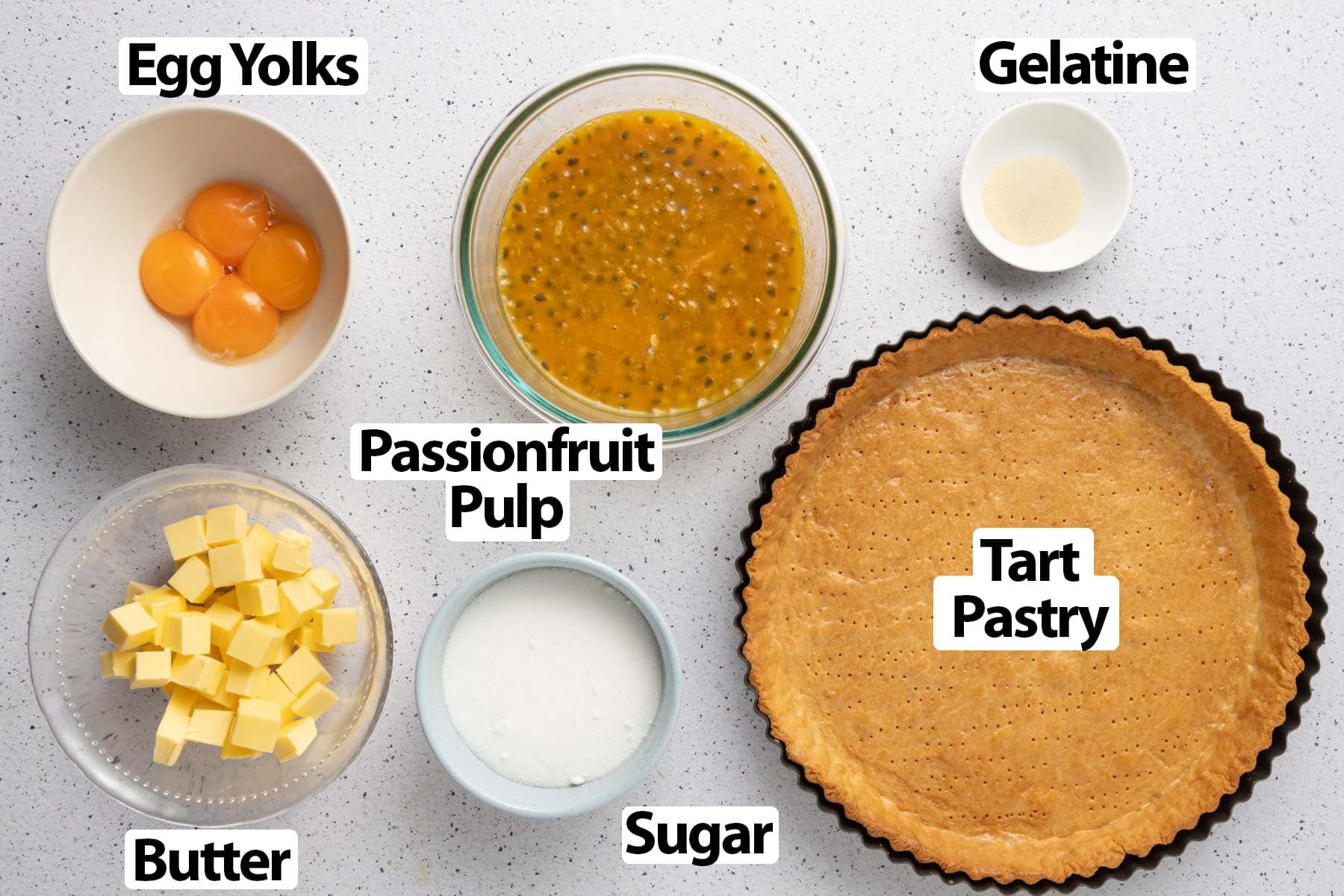
Scroll down to recipe card below for all quantities
What is passion fruit tart made of:
For the Sweet Shortcrust Pastry:
- Wet Ingredients: very soft unsalted Butter, Icing Sugar and large Egg at room temperature.
- Dry Ingredients: a mix of Almond Meal (or almond flour), Plain / All-Purpose Flour and a pinch of Fine Salt. You can replace the almond meal with the same quantity of plain flour if preferred.
For the Passion Fruit Filling:
- Passion fruit Pulp or Puree: the flesh found inside the passion fruits. You can keep the seeds for extra crunch or use a seedless puree if preferred. Note that passionfruit pulp is not the same as passion fruit juice, as it is thicker.
- Egg Yolks: only the yolks are required to make the crémeux but I used some of the leftover egg whites to make the meringue topping. You can also make some Financiers Cakes with them for example!
- Gelatine: I used gelatine powder that is dissolved into a little bit of very cold water, but you can use platinum strength gelatine sheets instead. It is equivalent to 1,5 to 2 gelatine leaves (depending on the strength).
- Butter: unsalted butter, at room temperature. Make sure it is not too soft / hot or too cold, or it won't emulsify nicely into the warm custard.
Optional Addition
I used some of the leftover Egg Whites from the Crémeux to make a Swiss Meringue and top the tart - but that is completely optional! Swiss Meringue is simply made off egg whites, caster sugar and a pinch of salt. To decorate, I simply used some fresh mint leaves.
How to make Passion Fruit Tart step-by-step
Making the Pâte Sucrée
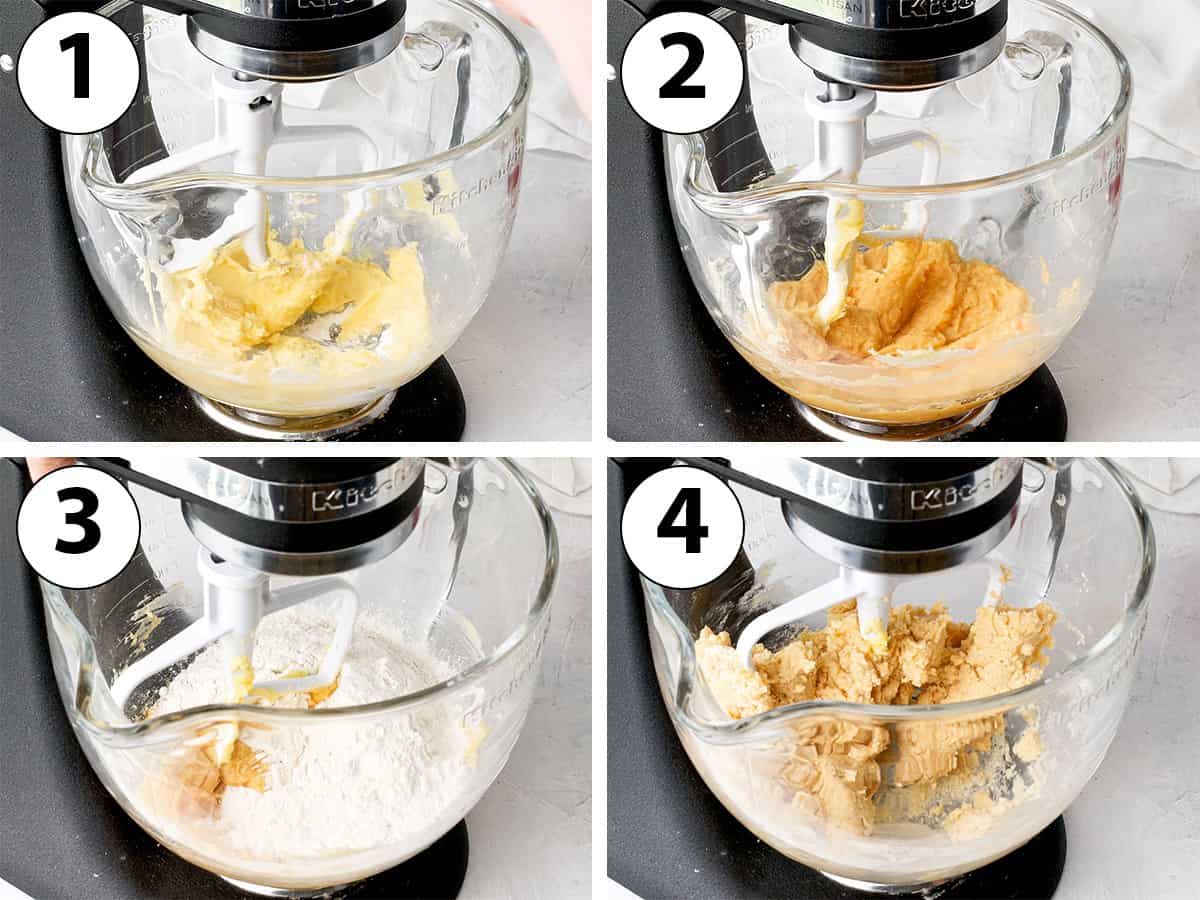
Making the dough:
- Photo 1: Place the soft butter and sifted icing sugar in the bowl of a stand mixer fitted with the paddle attachment (or in a large bowl if using an electric mixer). Mix on medium speed for a couple of minutes or until completely smooth. Scrape the bowl with a spatula if / when required.
- Photo 2: Add the egg and almond meal. Mix until well combined, stopping to scrape the side of the bowl when required. You should get a thick, slightly lumpy mixture.
- Photo 3: Add sifted flour and salt.
- Photo 4: Mix on low speed, stopping as soon as a rough dough comes together. You wan to avoid mixing the pastry for too long or it will develop too much gluten, making it hard to work with later on.
Optionally, do a "fraisage" (or "frasage") to finish combining the pastry. With the palm of your hand, gently press the dough against your kitchen table and move it forward. Pick it back up and place back over the centre of the pastry. Keep on going until the dough is very smooth.
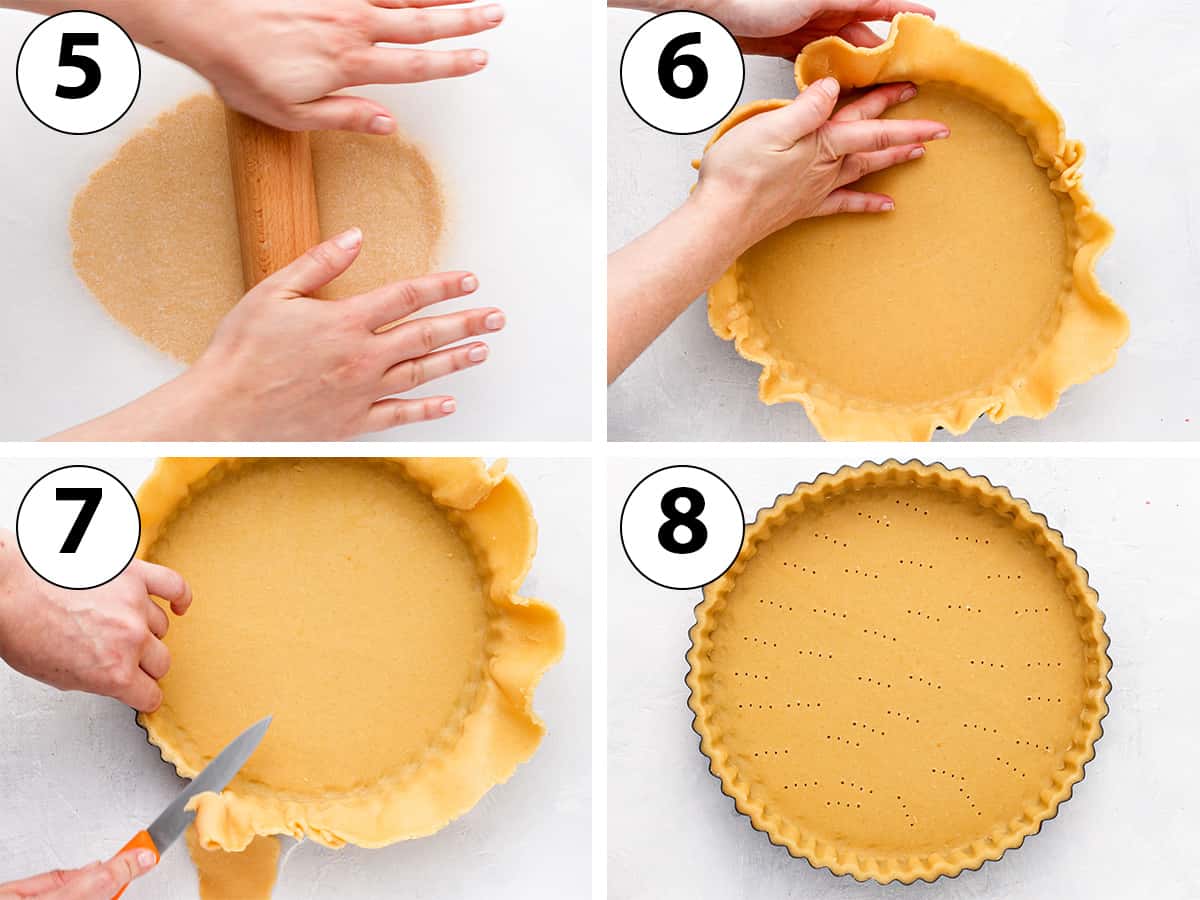
Rolling the dough & lining the tart pan:
- Bring the pastry together and place it between two large sheets of baking paper / parchment paper. Slightly press on the pastry ball to flatten it.
- Photo 5: roll the pastry to a thickness of about 4 mm (1/6 inch). Place the flat rolled pastry on a large baking sheet and chill for at least 1 hour (or up to 24 hours).
Tip: use a rolling pin with thickness rings to get an even thickness for your pastries!
- Photo 6: Remove the baking paper and transfer the pastry over a 24 cm (9,5-inch) tart tin, preferably with a removable bottom. Gently press the pastry down into the corner of the tart tin to create a 90 degree angle. If it cracks, you can patch it up with your fingertips.
If the pastry is too hard to be handled (cracks quickly, is too stiff), leave it at room temperature for a few minutes to let it soften a bit. If it gets too soft, place back in the fridge for a few minutes.
Note that this pastry is very forgiving so even if it cracks or breaks, you can simply use the warmth of your fingers to put it back together!
- Photo 7: Cut off any excess pastry with a small pairing knife. Place the lined tart pan in the fridge to chill and rest for at least 2 hour, preferably overnight (or for up to 24 hours).
- Photo 8: Preheat your oven on 160 degree Celsius / 325 degree Fahrenheit. Dock the pastry (prick the bottom of the pastry with a fork) and place the pastry in the freezer while the oven is preheating.
- Bake for 30 to 40 minutes or until the pastry is golden and feels dry to the touch. Place on a wire rack and leave to cool down completely.
I do not use beans, rice or baking weights to bake the sweet shortcrust pastry. As long as the pastry has been properly chilled and rested, it will not move in the oven.
Tip: to seal the bottom of the pastry, take the tart out of the oven 3 minutes before it has finished baking and brush it with some of the remaining egg whites. Place back in the oven to finish baking.
Making the Passion Fruit Filling
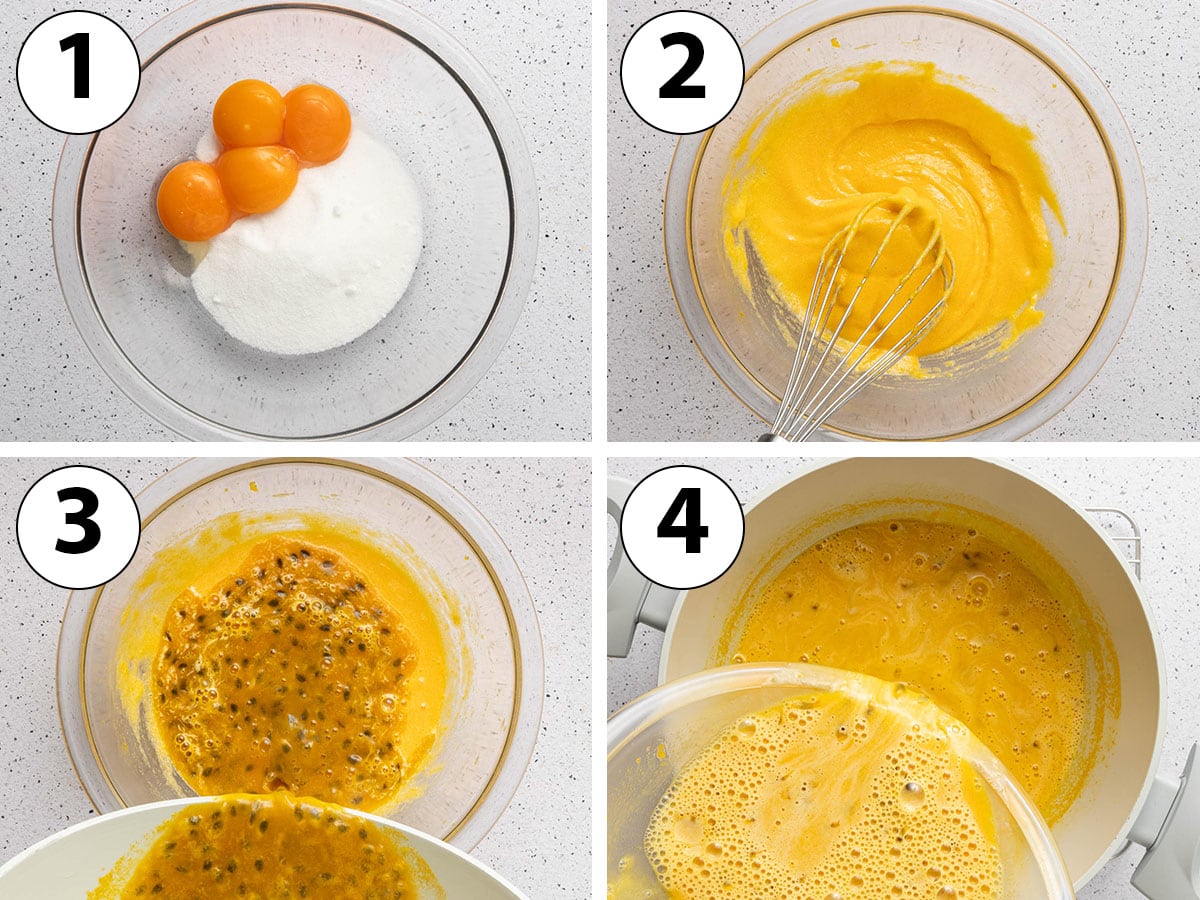
- Place the passion fruit puree in a medium saucepan. Turn on low to medium-low heat and cook until it starts to simmer.
- Photo 1 & 2: In the meantime, whisk together the egg yolks and sugar in a large heatproof bowl. It will be quite thick at the start but should thin out after a minute of whisking.
- Photo 3: Slowly pour the hot passion fruit over the egg/sugar mixture while continuously whisking.
This step is called "tempering". It allows to slowly bring up the temperature of the eggs to avoid cooking them too fast once transferred on the stove.
- Photo 4: Pour the whole mixture back in the saucepan and place on the stove over a low-heat.
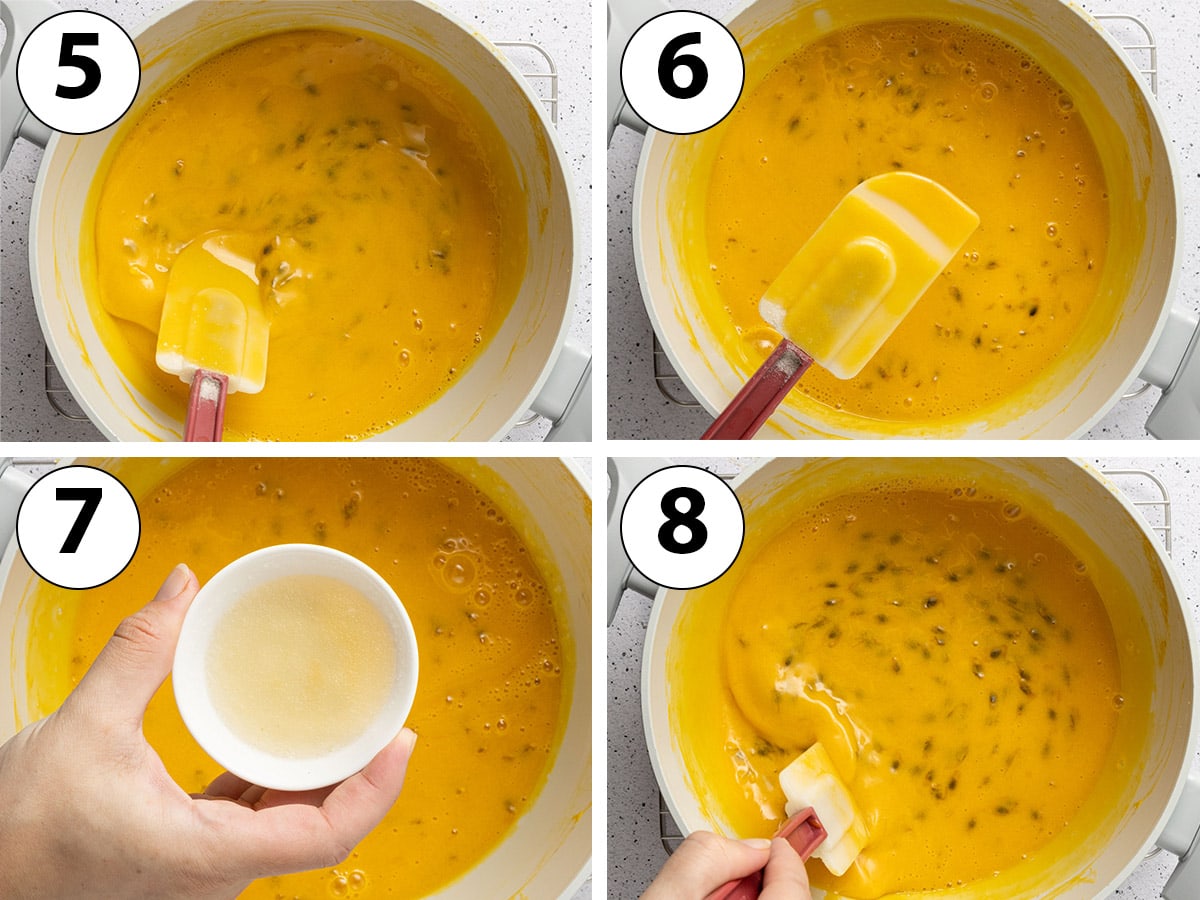
- Photo 5: continuously stir with a heatproof spatula or whisk for about 5 minutes over low heat - or until the custard mixture has slightly thickened. Remove from the heat.
The exact time can vary based on the exact temperature of your stove and the size of your pan. Make sure not to let the mixture boil or the egg yolks might curdle and turn the crémeux lumpy.
There are two ways to check that the crème anglaise base is properly cooked:
- Coat the back of a spoon with the custard (Photo 6). Carefully draw an horizontal line (it will be hot) and tip the spoon down. If the line stays clear, the custard is thick enough and ready to be used. If the cream is too liquid (not cooke enough), it will drip over the line.
- Use a thermometer to check that the cream has reached the temperature of 82 to 84 degree celsius (180 to 184 degree Fahrenheit). This technique is more precise.
- Photo 7: In a small bowl, mix the gelatine powder with a little bit of very cold water. Once it has solidified into a thick paste (2 to 3 minutes), add it to the hot passionfruit cream.
- Photo 8: Mix well until the gelatine has completely melted into the custard.
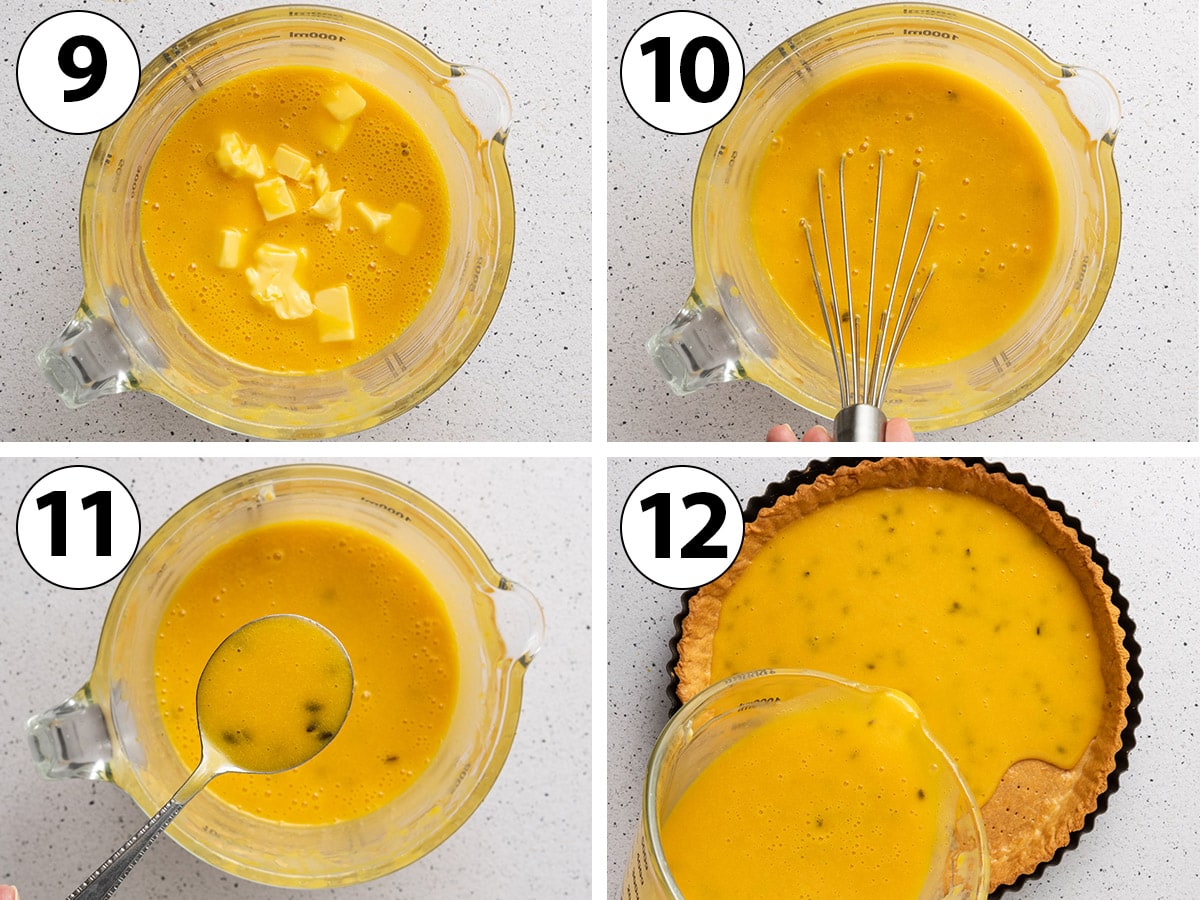
- Transfer the mixture into a clean bowl or large jug. Set aside and allow to cool down for 10 to 15 minutes, or until the temperature of the custard has dropped to about 40 degrees Celsius (105 degrees Fahrenheit).
It is very important to let the custard cool down before you add the butter. If too hot, the butter will melt into the custard (rather than emulsify) which could make the whole mixture split or look greasy.
- Photo 9: Add the soft butter cubes into the passion fruit custard a little bit at a time.
- Photo 10: Whisk well until the butter has been completely incorporated before adding more.
- Photo 11: Continue until all the butter has been added. You should get a rather thin, liquid mixture.
Note: the best way to incorporate the butter into a lukewarm custard is with an immersion blender. In this case, I do this step by hands to avoid crushing the passion fruit seeds and keep them whole. If you use a seedless passion fruit pulp, you can use an immersion blender instead of a whisk.
- Photo 12: Pour the passion fruit crémeux into the cool tart shell. Very gently tap the pan to pop any air bubbles. Place in the fridge to set for at least 3 to 4 hours, preferably overnight.
The passion fruit tart is ready! If you want to make something extra to finish it, you could top the dessert with a homemade Passion Fruit Coulis or Passion Fruit Curd. To lightly sweeten the dish, you can also serve it with some Chantilly Cream.
I decided to use some of the leftover egg whites and make a Swiss Meringue to finish the tart.
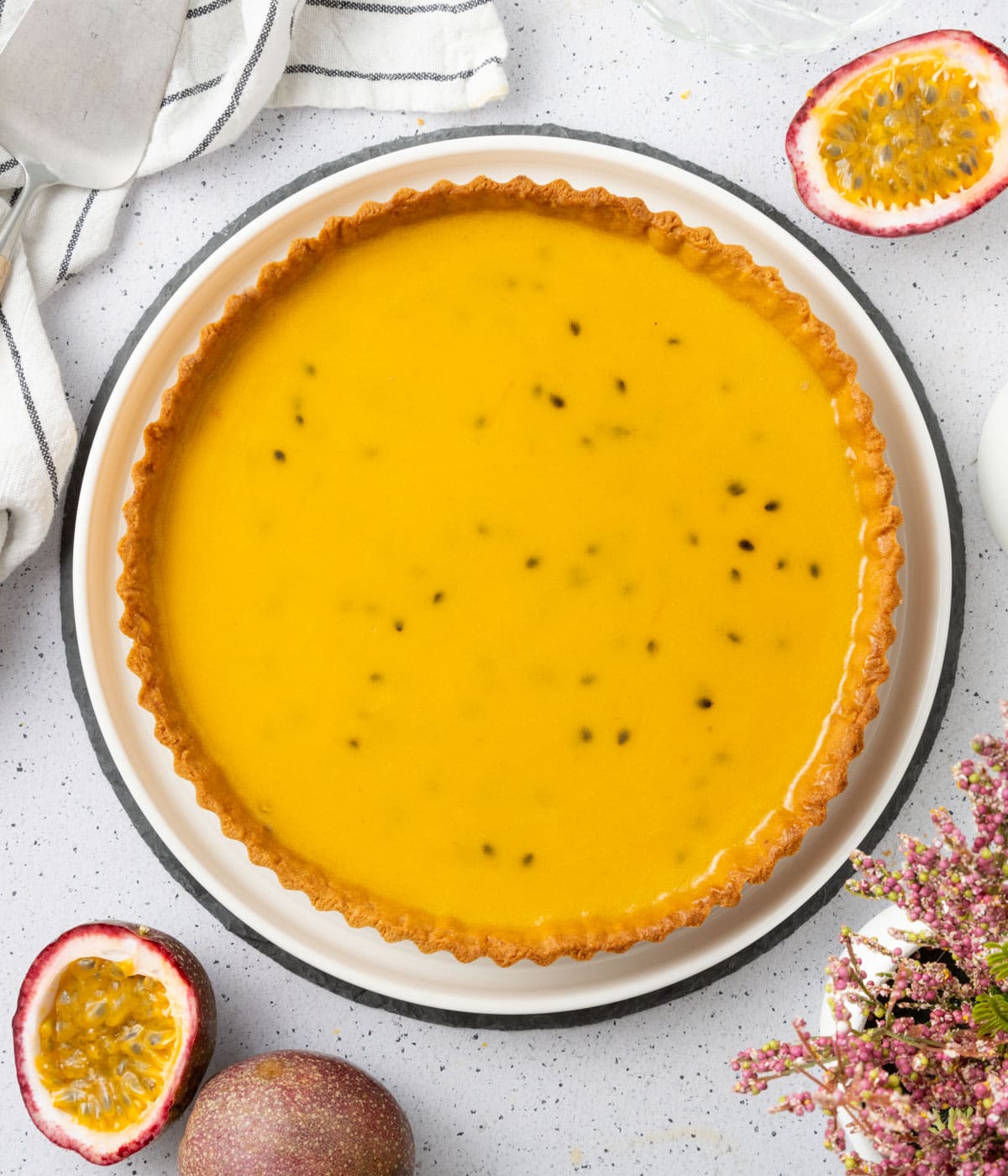
Optional Swiss Meringue Topping
To make a Swiss Meringue:
- Place the egg whites, caster sugar and salt in a heat-proof bowl. Whisk to combine then place over a double-boiler (pot of with boiling water that does not touch the bottom of the bowl once placed over).
- On a medium heat, continuously whisk for 5 to 10 minutes or until the egg whites have reached the temperature of 70 degrees Celsius (about 160 degrees Fahrenheit). The mixture should have turned white, thickened and increased in size.
- If you rub some of the mixture between your fingers, you shouldn't feel any grains of sugar anymore; it should have completely melted into the egg whites.
- Remove the bowl from the double-boiler and whip on medium to high speed (either using a hand mixer or a stand mixer fitted with the whisk attachment) until you reach stiff peaks. The meringue should be fluffy and glossy.
- Transfer the Swiss meringue into a piping bag fitted with a star-shaped nozzle. Piped over the set passion fruit tart in your preferred pattern then use a kitchen blowtorch to toast the meringue (optional). You can also just spread the meringue straight onto the tart if you don't want to pipe it.
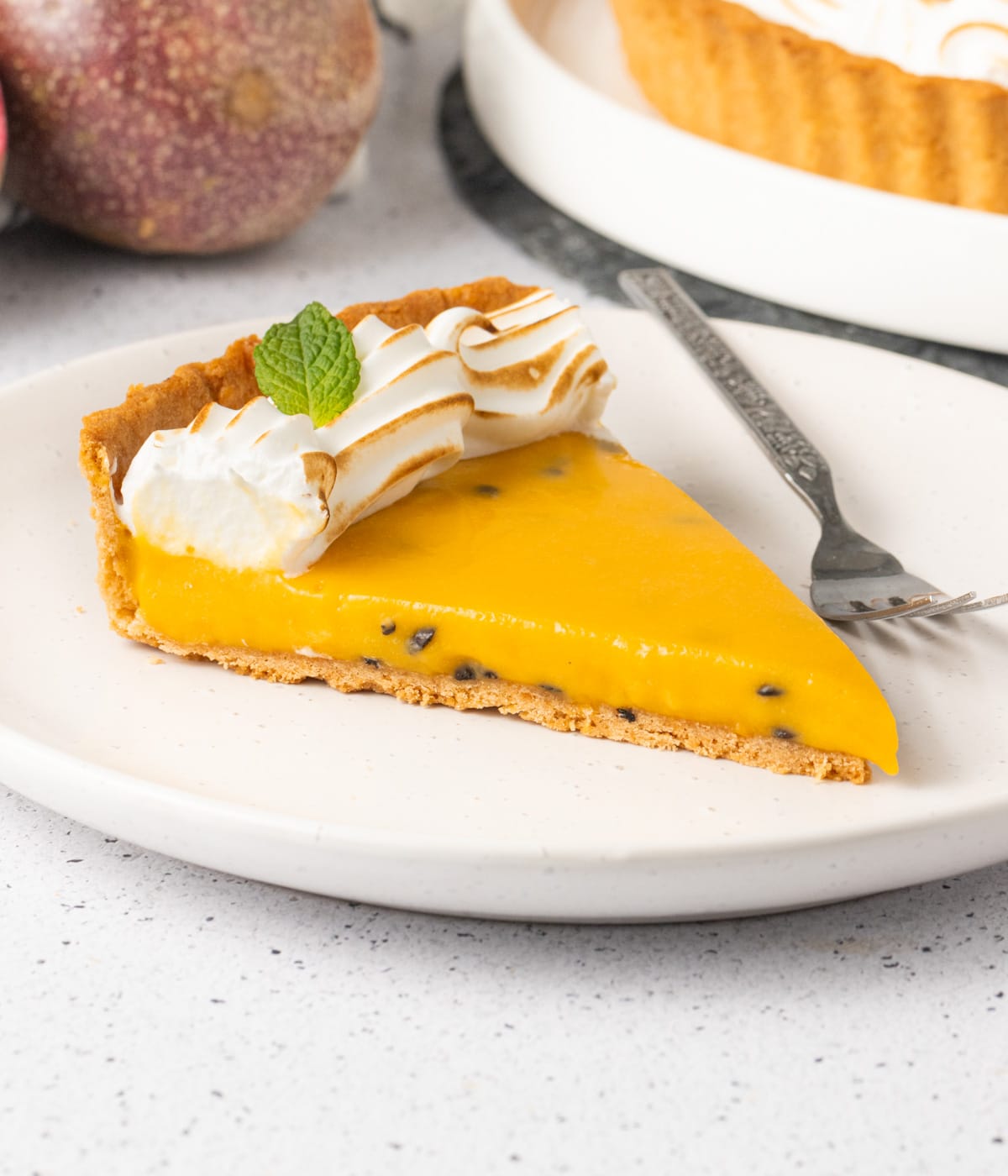
Recipe FAQs
A Pâte Sucrée crust is my personal preference for this recipe as it offers the best texture, sweetness level and crunch to contrast the creamy and tangy filling. It is also a more sturdy pastry that won't turn soggy once filled.
If preferred, you could also use a shortcrust pastry, either using my Pâte Sablée recipe or a store-bought shortcrust pastry!
If you don't want to use your oven, you can simply substitute the baked tart shell with your favourite no-bake pie crust! The passion fruit filling does not require any oven baking.
Absolutely, using some frozen puree or pulp is actually the easiest way to make this recipe. And it means you can make this passionfruit tart all year long - not just when in season!
I don't recommend using canned passion fruit as it is usually preserved in a sweetened syrup. That extra sugar will throw off the flavour balance of the passion fruit tart, as well as change the texture of the cream filling.
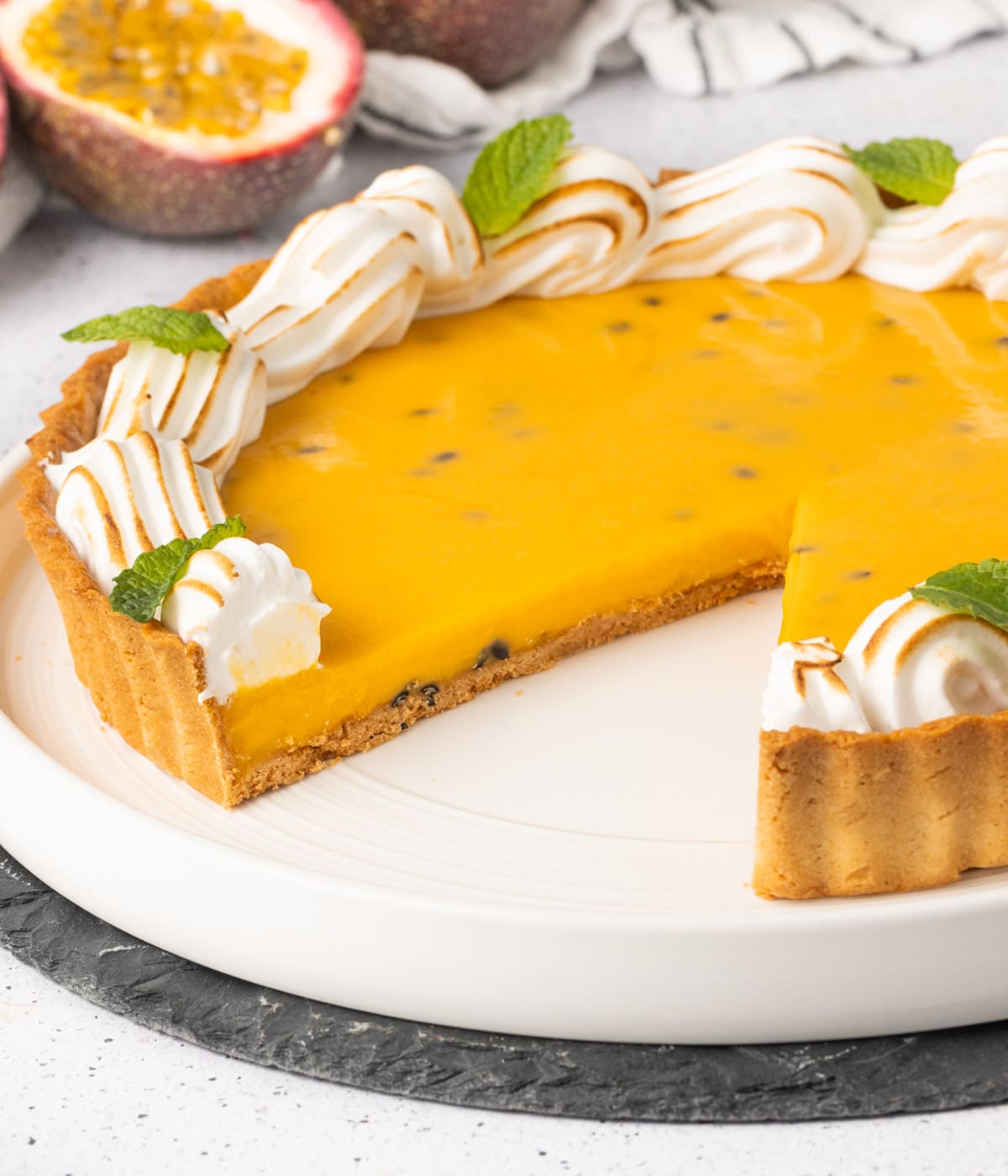
Tips & Troubleshooting
- Passion fruit seeds vs no seeds: it is completely up to you whether you want to keep the passionfruit seeds or not! I personally love the crunch it adds to the tart, but you can pour the pulp through a sieve to remove the seeds if preferred.
- Sweetness Level: the filling is relatively low in sugar as I personally love the super tangy taste of passion fruit. If you are after a sweeter taste, you can absolutely increase the sugar quantity. Make sure to taste the custard once it is cooked (before adding the gelatine or butter) and add more sugar to suit your taste if required.
- The tart crust is breaking or too soft to line the tart pan: the good news is, pâte sucrée is a super forgiving tart pastry and can easily be patched up with your fingers! If it is breaking while you line the tart pan, it is usually an indication that the pastry is too cold. If too soft to handle, place back in the fridge for a few minutes.
- The passion fruit crémeux is gritty or lumpy: this can happen if you over-cooked the custard and the egg yolks started to scramble. Make sure to cook the crémeux on low heat and not let it boil. For a perfect result, use a kitchen thermometer to check the temperature of the custard.
- The filling is not setting: it will take a few hours of chilling for the passionfruit filling to set. If after a few hours, it is still liquid, it could mean that you did not use enough gelatine and/or it wasn't mixed in or melted properly into the custard.
Storing & Freezing
This passion fruit tart should be kept in the fridge. It is best served within 24 hours but will last for up to 3 days when refrigerated.
If you want to serve the tart with the meringue topping, I recommend adding it as close to serving as possible. That is because meringue tends to weep / melt when kept in the fridge for too long.
I do not recommend freezing the tart, but the crust itself can be made in advance and frozen either raw (flat, between two sheets of baking paper) or once fully baked (well wrapped in plastic wrap and/or aluminium foil).

I am so excited to share that my debut cookbook
"Bite-Sized French Pastries for the Beginner Baker"
was released in December 2023!

Recipe

Passion fruit tart
Ingredients
Pâte Sucrée Pastry
- 100 gr Unsalted Butter - soft, at room temperature
- 50 gr Icing Sugar
- 1 large Egg - at room temperature
- 40 gr Almond Meal
- 200 gr Plain / All-Purpose Flour
- 1 pinch Fine Table Salt
Passion Fruit Crémeux
- 300 gr Passion Fruit Pulp or Purée
- 4 large Egg Yolks - at room temperature (approx 80 grams)
- 120 gr Caster Sugar
- 5 gr (1 1/2 teaspoon ) Gelatin Powder - plus 1 tablespoon cold water
- 120 gr Unsalted Butter, cubed - at room temperature
Meringue Topping (optional)
- 2 large Egg Whites - (approx 60 grams)
- 60 gr Caster Sugar
- 1 pinch Fine Table Salt
Disclaimer
I highly recommend using the measurements in grams & ml (instead of cups & spoons) for more accuracy and better results.
Instructions
Pâte Sucrée Pastry
- Place the soft butter and sifted icing sugar in the bowl of a stand mixer fitted with the paddle attachment. Mix on medium speed for a couple of minutes or until completely smooth. Scrape the bowl with a spatula if / when required.
- Add the egg and almond meal. Mix until well combined, stopping to scrape the side of the bowl when required.
- Add sifted flour and salt. Mix on low speed, stopping as soon as a rough dough comes together (see note 1).
- Bring the pastry together and place it between two large sheets of baking paper / parchment paper. Slightly press on the pastry ball to flatten it. Roll the pastry to a thickness of about 4 mm or 1/6 inch (see note 2). Place the flat pastry on a large baking sheet and chill for at least 1 hour (or up to 24 hours).
- Remove the baking paper and place the pastry over a 24 cm (9,5-inch) tart tin with removable bottom. Gently press the pastry down into the corner of the tart tin to create a 90 degree angle (see note 3).
- Cut off any excess pastry with a small pairing knife. Place back in the fridge to chill and rest for at least 2 hour, preferably overnight (or for up to 24 hours).
- reheat your oven on 160 degree Celsius / 325 degree Fahrenheit. Dock the pastry (prick the bottom of the pastry with a fork) and place the pastry in the freezer while the oven is preheating. Bake for 30 to 40 minutes or until the pastry is golden and feels dry to the touch (see note 4). Place on a wire rack and leave to cool down completely.
Passion Fruit Crémeux
- Place the passion fruit puree in a medium saucepan. Turn on low to medium-low heat and bring to a simmer.
- In the meantime, whisk together the egg yolks and sugar in a large heatproof bowl. Slowly pour the hot passion fruit over the egg/sugar mixture while continuously whisking. Pour the whole mixture back in the saucepan.
- Place back on the stove over a low-heat. Continuously stir with a heatproof spatula or whisk for about 5 minutes, or until the custard mixture has slightly thickened (see note 5). Remove from the heat.
- In a small bowl, mix the gelatine powder with a little bit of very cold water. Once it has solidified into a thick paste (2 to 3 minutes), add it to the hot passion fruit custard. Whisk well until the gelatine has completely melted.
- Transfer the mixture into a clean bowl or large jug. Leave to cool down for 10 to 15 minutes, or until the temperature of the custard has dropped to about 40 degrees Celsius (105 degrees Fahrenheit) (see note 6).
- Add the soft butter cubes into the passion fruit custard a little bit at a time, whisk well until the butter has been completely incorporated before adding more.
- Once all the butter has been incorporated, pour the liquid passion fruit crémeux into the baked tart shell. Very gently tap the pan to pop any air bubbles. Place in the fridge for at least 3 to 4 hours (preferably overnight) or until the filling has set.
Meringue Topping (optional)
- Place the egg whites, caster sugar and salt in a heat-proof bowl. Whisk to combine then place over a double-boiler. On a medium heat, continuously whisk for 5 to 10 minutes or until the egg whites have reached the temperature of 70 degrees Celsius (about 160 degrees Fahrenheit). The mixture should have turned white, thickened and increased in size (see note 7).
- Remove the bowl from the double-boiler and whip on medium to high speed, either using a hand mixer or a stand mixer fitted with the whisk attachment. Continue to whip until you reach stiff peaks and the meringue is glossy and fluffy.
- Transfer the Swiss meringue into a piping bag fitted with a star-shaped nozzle. Piped over the set passion fruit tart in your preferred pattern then use a kitchen blowtorch to toast the meringue (optional). You can also just spread the meringue straight onto the tart if you don't want to pipe it. Finish with a few leaves of fresh mint (optional).
Tried this recipe? Make sure to leave a comment and star rating below!
Notes
- You wan to avoid mixing the pastry for too long or it will develop too much gluten, making it hard to work with later on. Optionally at this stage, you can do a "fraisage" (or "frasage") to finish combining the pastry. With the palm of your hand, gently press the dough against your kitchen table and move it forward. Pick it back up and place back over the centre of the pastry. Keep on going until the dough is very smooth.
- To get a perfect, even thickness, use a rolling pin with thickness rings.
- If the pastry is too hard to be handled (cracks quickly, is too stiff), leave it at room temperature for a few minutes to let it soften a bit. If it gets too soft, place back in the fridge for a few minutes. This pastry is very forgiving so even if it cracks or breaks, you can simply use the warmth of your fingers to put it back together!
- I do not use beans, rice or baking weights to bake the pastry. As long as it has been properly chilled and rested, it will not move in the oven.
- The exact time can vary based on the exact temperature of your stove and the size of your pan. Make sure not to let the mixture boil or the egg yolks might curdle and turn the crémeux lumpy. There are two ways to check that the crème anglaise base is properly cooked: - Coat the back of a spoon with the custard. Carefully draw an horizontal line (it will be hot) and tip the spoon down. If the line stays clear, the custard is thick enough and ready to be used. - Use a thermometer to check that the cream has reached the temperature of 82 to 84 degree celsius (180 to 184 degree Fahrenheit).
- It is very important to let the custard cool down before you add the butter. If too hot, the butter will melt into the custard (rather than emulsify) which could make the whole mixture split or look greasy.
- If you rub some of the mixture between your fingers, you shouldn't feel any grains of sugar anymore; it should have completely melted into the egg whites.
Nutrition
Made this recipe?
Let us know if you liked it by leaving a comment below, and tag us on Instagram @a.baking.journey with a photo of your creation!


